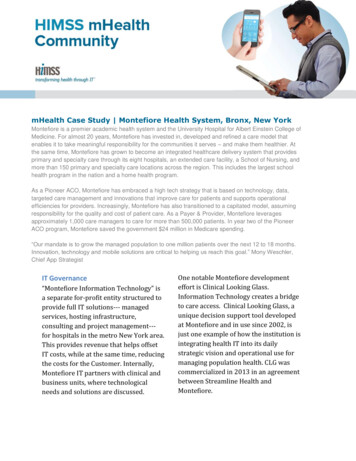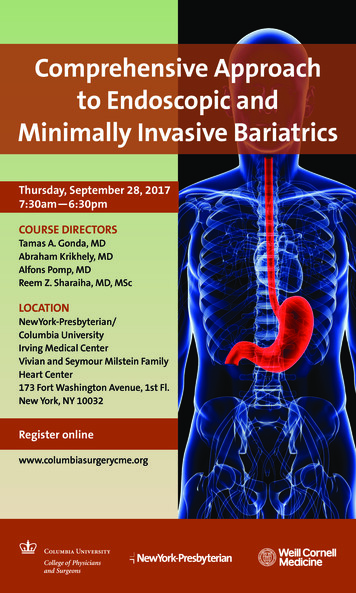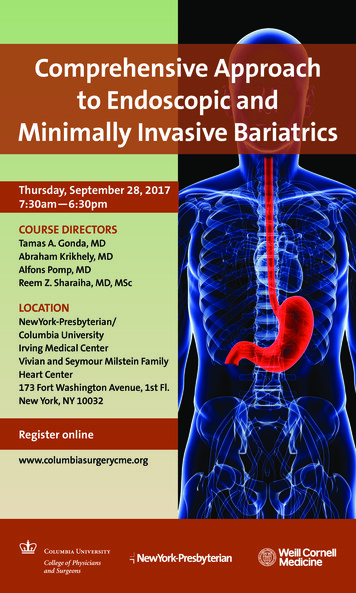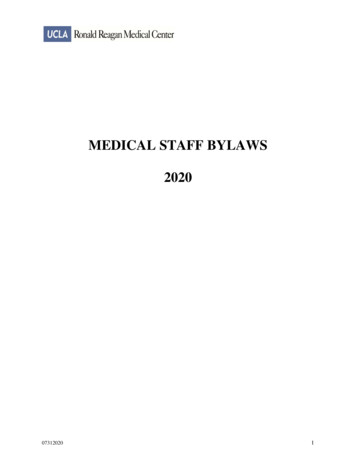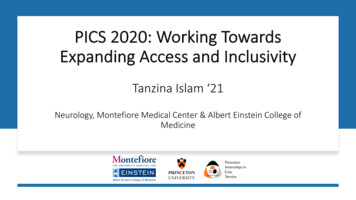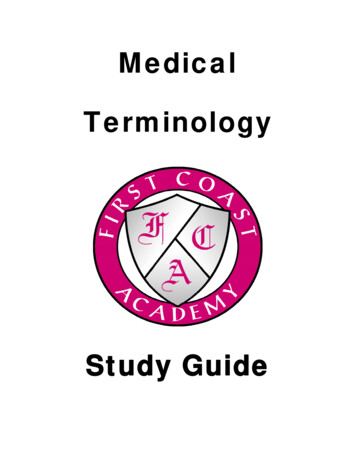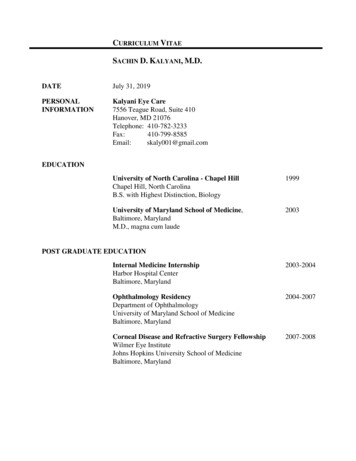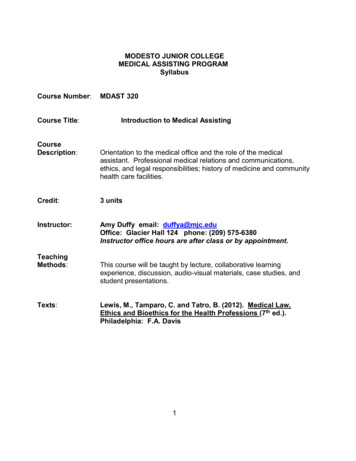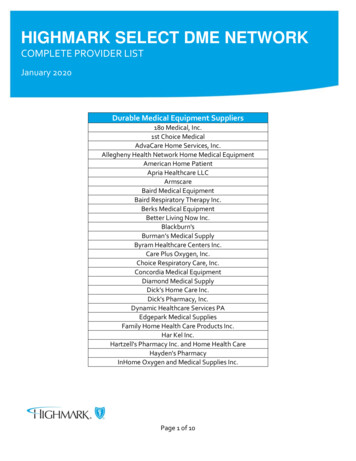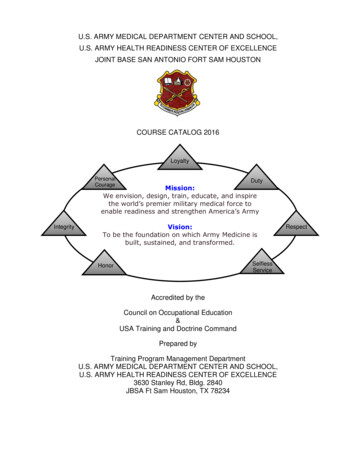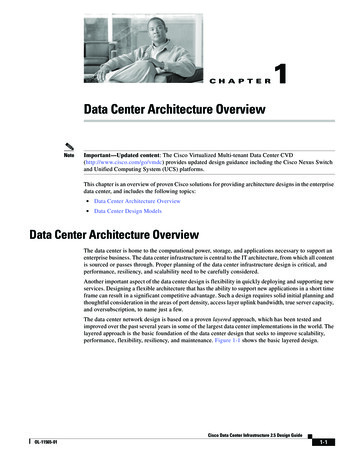
Transcription
2012 annual report
Heal. Teach. Discover. Advance.ContentsLetter from the Chairman & President 3Visionary Model Of Integrated Care 4– Academic medical center 6– integrated care delivery 20– community commitment 34leading change 42a legacy of service 44montefiore by the numbers 2012 50Montefiore Medical Center’s success has beendriven by a passionate commitment to ourvalues — humanity, innovation, teamwork,diversity and equity — which have informedour legacy of service throughout our history,including our 100 years in the Bronx.Providing compassionate care where, whenand how our patients need it — with a singlestandard of excellence for all — we have servedour community with distinction and raisedthe bar for medical centers around the world.montefiore hospital forchronic diseases, 1920sMontefiore moves from the more denselypopulated northern Manhattan to the greencountryside in the Bronx. The hospital’s mainbuilding on Gun Hill Road opened in 1913,maintaining its focus on the “incurables.”Front cover: (left) Janet Lipson, a pancreatic cancer survivor; (right) Crystal Gabbe, an osteosarcoma patient and survivor, plays with her father, Roger Gabbe.Inside front cover: Kathy O’Donnell, who underwent a mitral valve repair, hugs her mother.1
(Left)Steven M. Safyer, MDPresident andChief Executive Officer(Right)David A. TannerChairman,Board of Trustees2100 years in the bronxmontefiore 2012 annual reportLetter from the chairman and the Presidentsetting a higher standardin a changing healthcare environmentMontefiore had a strong 2012. Driven bya passion for innovation and excellence, wecontinue to improve the health and enrichthe lives of our patients, their families andour communities.We made some significant leadershipappointments in 2012. Philip O. Ozuah,MD, PhD, assumed the role of Executive Vice President and Chief OperatingOfficer; Andrew D. Racine, MD, PhD,was promoted to Senior Vice Presidentand Chief Medical Officer, with oversightof Montefiore Medical Group; AlfredoCabrera was recruited as Senior VicePresident and Chief Human ResourcesOfficer; and Lynn Richmond, NP, wasappointed Senior Vice President andChief of Staff. In addition, we implemented a new clinical leadership modelfocused at the local, campus level —redesigning ourselves to increase accountability, improve the patient experienceand quality of care, and lay the foundationfor our future growth.Our partnership with Albert EinsteinCollege of Medicine continues to deepenthrough multidisciplinary research andteaching collaborations. In 2012, ourclinicians were engaged in an extraordinary amount of exciting research, withnearly 450 active clinical trials. As thesecond largest graduate training programin the country, our residents and fellowsparticipate in 84 accredited programs,including four new ones in areas such asPain Medicine and Female Pelvic Medicine& Reconstructive Surgery. Together withthe nurses, social workers, pharmacists andothers who are educated across our system,we are building a diverse pipeline of newhealthcare leaders.We continue to develop innovativeapproaches to integrating care across thehealthcare continuum. Montefiore hadclose to three million ambulatory visitsthroughout 2012. As our healthcaresystem evolves, more and more care isbeing provided outside of the hospitalsetting — through advances in informationand medical technology and providingthe right care in the most effective andefficient ways.The growth of our ambulatory practices over the past year reflects this shift.We opened six new locations in order tomeet the needs of the region, includingorthopaedic specialists now available at theWakefield and Hutchinson Campuses anda new ophthalmology outpatient facility atWakefield. We broke ground last year onthe Hutchinson Tower, a “hospital withoutbeds,” to provide ambulatory care servicesin a brand new, 280,000-square-foot,11-story facility that will ease inpatientpressure on our hospitals. Our MontefioreMedical Group also developed a newprimary care site at Via Verde, an affordablehousing complex in the South Bronxthat emphasizes eco-friendly design andhealthy living.We are focused on achieving fullaccountability for our region. We haveincreased the number of people for whomwe are accountable for the quality andcost of their care from 170,000 to close to250,000. Working across highly integratedteams of physicians, nurses, social workers,mental health professionals and othercaregivers, we have developed a pioneeringcare management and coordination approachthat intercedes for and supports thepatient — focusing on communication,coordination, engagement and preventionto provide higher quality, humanistic careand better outcomes, while containingthe unnecessary costs associated withfragmented healthcare.Montefiore is providing care when andwhere people need it — their homes, theirdoctors’ offices, via telephone, in schools,in rehab or in the hospitals. As we continueto navigate the healthcare environmentand play a leadership role in its future,Montefiore has stayed true to its mission,taking meaningful responsibility for itscommunity. We believe that everyonedeserves the same standard of excellentcare, regardless of their background orability to pay.More than 125 years after our foundingand 100 years in the Bronx, we continueto be guided by our strong values. Whatwe have learned along the way is that doingthe right thing leads to great achievementsand lights the way toward a promising future.David A. TannerChairman, Board of TrusteesSteven M. Safyer, MDPresident and Chief Executive Officer3
Visionary Model of Integrated CareacademicmedicalcenterVisionary Model ofIntegrated micMedicalCenter4100 years in the bronxmontefiore 2012 annual reportIntegrated CareDeliverypage 6CommunityCommitmentpage 20page 345
Visionary Model of Integrated CareAcademic Medical CenterIn the heart of one of the nation’s most economicallyand health-challenged communities, Montefiore istransforming the way healthcare is delivered, providingscience-driven, patient-centered care. As the UniversityHospital for Albert Einstein College of Medicine,we have partnered to create interdisciplinary Centersof Excellence that seamlessly connect patient care,research and education and ensure an environment ofcontinual innovation and learning. From the breadthand depth of our clinical trials and the development ofthe next generation of healthcare leaders, to our focuson taking meaningful responsibility for the wellness ofa diverse community, we are committed to advancingthe future of healthcare.gAcademicintegrated CommunityMedical Center care Delivery commitmentResearchOur partnership with Albert EinsteinCollege of Medicine yields extensivebiomedical research, with an emphasison translating basic science in the lab topioneering treatments and therapies forthe benefit of seenPatient Care1,317residentsPatient care at Montefiore isdistinguished by a humanistic approachthat addresses patient and familyconcerns, inspires our commitmentto the highest quality in the safestenvironment, and drives us to find themost effective diagnostic and treatmentoptions to promote long-term health.EducationWith a reputation for providingexceptional clinical training, Montefiorehas the second largest residencyprogram in the United States. Ourphysicians, leaders in their fields,mentor a new generation of medicaltalent committed to excellence.nursing school laboratory, 1922Montefiore established a School of Nursingin 1922 specifically to train nurses for servicein a chronic disease hospital. Nursing oflong-term illness required special qualities,and included scientific research.6100 years in the bronxmontefiore 2012 annual report9
Notable Centers of Excellence 2012 HighlightsNotable Centers of Excellence 2012 HighlightsThe Children’s hospitalat montefioreAdmissions increased by 8 percent in 2012 at TheChildren’s Hospital at Montefiore (CHAM), wherewe combine innovative science, leading technologyand clinical expertise with a unique family-centeredapproach to care.“We are committed to advancing the health ofthe communities we serve, and have expanded ourpresence in the Bronx and Westchester — makingCHAM’s talented physicians accessible to patientsthroughout the entire region,” says Philip O. Ozuah,MD, PhD, Executive Vice President and ChiefOperating Officer, Montefiore, and Professor,Pediatrics and Epidemiology & PopulationHealth, Einstein.CHAM’s increasing volumes and services haveled the hospital to pursue additional clinical space.In 2012 CHAM expanded the Pediatric CriticalCare Unit (PCCU) by four beds, and additionalrenovations under way will bring the PCCU fromits current 20 to 26 beds.With this growth comes continued improvementin CHAM’s quality of care — and its success inmanaging complex cases — as reflected in ournationally recognized programs in pediatricnephrology, neurology/neurosurgery, orthopaedics,diabetes/endocrinology, cardiology, oncology,gastroenterology and solid organ transplantation.All of these specialties are anchored byCHAM’s primary pediatric care — fromproviding childhood vaccines to employing amultidisciplinary approach for such persistentchronic diseases as asthma and diabetes.In 2012, for example, CHAM helped toreduce both total and repeat admissionsfor diabetic ketoacidosis in children withpreexisting type 1 diabetes by 30 percent.Through education, support groups andclinical efforts, total and repeat admissionswere reduced by 44 and 54 percent ascompared with 2011.CHAM’s comprehensive and leading-edgecare is informed by the latest research.Clinical trials range in scope from newapproaches to the treatment of sarcomas,sickle cell anemia, brain tumors and leukemiato protocols designed to determine theprevalence and metabolic correlates ofsleep-disordered breathing and excessivedaytime sleepiness in adolescent girls withpolycystic ovarian disease.U.S. News & World Report hasrecognized CHAM as one of thetop children’s hospitals in theUnited States for the past five years.100 %CHAM has achieved a 100 percent one-year survivalrate for kidney transplants.95 %CHAM has achieved a 95 percent rate for cardiacablation procedures.770 %The National Institutes of Health (NIH) hasincreased its support of CHAM research by 770percent since 2000.Notable Centers of Excellence 2012 Highlightsmontefiore einstein centerfor cancer careThrough pioneering research and state-of-the-artclinical care, the Center for Cancer Care bringstogether multidisciplinary teams to prevent,diagnose and treat both rare and common formsof cancer.In 2012, the Center centralized nine of itsclinical service specialties in one location tostrengthen patient care and treatment, and addeda psychosocial oncology program to its outpatientfacility at Jarrett Place, to help patients and theirfamilies deal with the emotional difficulties ofcancer diagnosis and treatment.To further improve cancer treatment andrecovery, the Center became the first facility in theNortheast to offer a complete “regional” perfusiontherapy program, which targets anti-cancer drugsto four specific tumor sites in the body, to reducetoxicity and spare healthy tissue. “The Center forCancer Care, in collaboration with the Departmentof Radiology, was also the first on the East Coastto use a new radiofrequency ablation system thatdelivers energy directly into a metastastic spinaltumor to heat and destroy tumor cells and providepalliative relief,” adds Steven Libutti, Director,Montefiore Einstein Center for Cancer Care;Vice Chairman, Surgery; and Professor, Surgeryand Genetics, Montefiore and Einstein.To find new treatments, the Center for CancerCare is currently conducting more than 100 activeclinical trials. In 2012, clinical trials began, inpartnership with the Albert Einstein Cancer Center,on novel nanotechnology-driven chemotherapiesfor metastatic lung cancer and pancreatic cancer.These therapies enable surgeons to target the tumordirectly while minimizing toxicity to the patient.Researchers also discovered a biomarker in headand neck cancers that can detect the level of riskimmediately following diagnosis — a discoverythat could become part of a new test to guidehow aggressively head and neck tumors shouldbe treated.Pediatric Hematology / Oncology Treatment and Visits11,124Outpatient Radiation Oncology and Medical Oncology Treatmentsand Visits82,701Visits to Jarrett Place Active Clinical Trials 11,284128Montefiore einstein centerfor heart and vascular careThe Center is a national leader in theprevention, diagnosis and treatment ofheart and vascular disease. From high-techdiagnostics to lifestyle management tostate-of-the-art surgery, the Heart & VascularCenter uses a range of proven tools andtechniques to improve cardiac and bloodvessel health. The Heart & Vascular Center is known forits success with heart transplants, minimallyinvasive cardiac surgery, and the use ofmechanical assist devices and robotics, amongother surgical techniques. Montefiore is able to achieve extraordinarilyclear pictures of the heart and arteries,using groundbreaking technologies such astransesophageal echocardiography. A nationally recognized leader in mitral valverepair, the Heart & Vascular Center providespatients with a cutting-edge alternative toreplacing damaged valves: fixing native valvesusing a complex surgical approach called the“butterfly” technique.“One recent example of the Heart & VascularCenter’s innovative work is transcatheteraortic-valve replacement (TAVR). Performedfor the first time at Montefiore in 2012,this groundbreaking therapy is an effectivetreatment for aortic valve disease, whichaffects more than 1.5 million people in theUnited States,” says Robert E. Michler, MD,Surgeon-in-Chief, Montefiore, Co-Director,Montefiore Einstein Center for Heart &Vascular Care, and Professor and Chairman,Cardiovascular and Thoracic Surgery andSurgery, Montefiore and Einstein.By bringing together expertise acrossdisciplines, researchers are finding novel solutionsto long-standing problems. Dovetailing on itssuccessful pediatric extracorporeal membraneoxygenation (ECMO) program — a temporaryheart/lung bypass machine that puts oxygenin the bloodstream and pumps the newlyoxygenated blood to the body — Montefioreinstituted an adult ECMO service thatreceives referrals from across the region.Risk-adjusted operativemortality rates at the Centerare among the lowestin the nation.100thIn 2012, the Center performed its 100th hearttransplant while achieving the highestone-year post-transplant survival rate inNew York State.Top 15%The Center was awarded a top rating ofthree stars — for the third consecutiveyear — by the Society of Thoracic Surgeons,an honor given to less than 15 percent ofparticipating hospitals in the United States.Notable Centers of Excellence 2012 Highlights Two research teams from Montefiore and Einsteinreceived prestigious grants from the NationalCancer Institute, totaling 3 million over fiveyears, to investigate neglected or unexploredareas that will enhance efforts to prevent, treatand cure the disease. The Bone Marrow Transplant Program hasbeen reaccredited by the Foundation for theAccreditation of Cellular Therapy, a nonprofitorganization founded to promote excellence inclinical therapy. Montefiore Einstein Center for Cancer Carereceived the national 2012 Commission onCancer’s Outstanding Achievement Awardin recognition of its leadership in deliveringexemplary cancer care.The Center for Cancer Care’s thirteen clinicalservice specialties include:Breast Cancer Colorectal CancerEndocrine / Neuroendocrine OncologyGynecologic Oncology Head and Neck CancerHematologic Oncology HepatobiliaryCancer Lung Cancer Melanoma / SarcomaNeuro-Oncology Pancreas / Upper GI CancerPediatric Oncology Urologic OncologyMontefiore einstein centerfor transplantationIn 2012, the Center performed 137 kidneytransplants, 30 liver transplants, and 28heart transplants in adults and children withsurvival rates that are among the best in thenation. Staffed by world-renowned surgeonsand physicians who partner with researchpioneers at Albert Einstein College ofMedicine, the Center is elevating the standardof care for transplant patients and improvingtheir quality of life, while advancingknowledge about the diseases that causeorgan failure.“The Center also performed eight livertransplants for hepatocellular carcinoma witha 93 percent one-year survival rate, comparedwith 89 percent for the United States as awhole,” says Milan Kinkhabwala, MD, Chief,Division of Transplantation, Department ofSurgery, Montefiore, and Professor, Surgery,Einstein. “We have a very aggressive programof pre-transplant bridge therapy for cancerpatients who are waiting for liver transplant.”With more than four decades of experiencein organ transplantation, the Center forTransplantation offers a second chance at lifefor patients struggling with advanced heart,liver, pancreas and kidney failure. A key partof the Center’s success is its holistic approach,which includes comprehensive psychosocialsupport for patients and their families.In this past year, the Center launched a newprogram, the Helping Hands program, tohelp patients in need to meet the enormousfinancial and psychosocial challengesassociated with organ transplantation. Theaim of Helping Hands is to strengthencontinuity of care and compliance withdifficult medical regimens, provide comfortand reassurance, and assist caregivers whomay themselves need support in their role ashealthcare partners for their loved ones.100 %Our one-year survival rate for pediatric kidneytransplants is 100 r survival rateone-year survival rate65%33%hospitalized prior totransplantationhospitalized prior totransplantationMany Montefiore patients aresicker prior to transplantation,yet the survival rate is wellabove the national average.95 %Our one-year survival rate for adult kidneytransplants is nearly 95 percent.
MONTEFIORE EINSTEINCENTER FOR HeartAND VASCULAR CARETHE CHILDREN’SHOSPITAL ATMONTEFIORECrystal GabbeMario J. Garcia, MDCancer PatientChief, Cardiology, andCo-Director, Montefiore EinsteinCenter for Heart and Vascular CareProfessor, Medicine and Radiology,Einsteingiven the chance to growWhen 2-year-old Crystal Gabbe was diagnosedwith a rare bone cancer, Ewing sarcoma, TheChildren’s Hospital at Montefiore (CHAM)team — led by Richard Gorlick, MD, Chief, PediatricHematology and Oncology, Montefiore, and ViceChairman and Professor, Pediatrics, Montefioreand Einstein; and David Geller, MD, Director,Orthopaedic Oncology Service, Montefiore,and Assistant Professor, Orthopaedic Surgeryand Pediatrics, Einstein — not only successfullyremoved the tumor in her leg, but also createda special prosthesis that can be made longer tokeep up with her growth.10100 years in the bronxlearning from leaders“For us, it’s not enough just to cure patients;we want them to have happy, productive lives,”says Dr. Geller. “In order to be able to walk andgrow, Crystal needed surgery that involvedremoving the whole tumor and rebuilding her hip,”he adds. “Providing this adaptable prosthesis willenable her to use her leg normally as she grows.”Another key to success with children likeCrystal “is the seamless care that helps ouryoung patients feel comfortable and calm,”says Dr. Gorlick. “Even with chemotherapy, wetry to keep patients home with their families asmuch as possible.”montefiore 2012 annual reportCrystal continues to come to Montefiore forregular visits to monitor her status and have herprosthesis adjusted as she grows.“Just to see Crystal walking again after thesurgery and chemotherapy and knowing she willgrow up normally is an incredible feeling,” saysher father, Roger.Mario J. Garcia, MD, Chief, Cardiology, andCo-Director, Montefiore Einstein Center for Heartand Vascular Care, and Professor, Medicine andRadiology, Einstein, is an internationally renownedleader in developing and advancing cardiacdiagnostic technology. His expertise in interpretingcardiac imaging — and his ability to teach theseskills to medical students, residents and evenphysician colleagues in related specialties — isvitally important for providing the best care andpreparing the next generation of cardiologists andcardiac surgeons.“We’ve created an environment of continuallearning because the technology is evolvingconstantly,” says Dr. Garcia. “Today we can makea very accurate assessment based on a detailed3D view of the heart and vascular anatomy andhow it functions — without risky and invasiveexploratory procedures.”Students also learn more and gain moreexperience than in the past, when dissectingcadavers was the norm. “With today’s ultrasoundand 3D imaging technology, they can see theheart’s structure and physiology much moreclearly,” he explains. “Residents have more toolsto help them learn the skill of examining patients,working physicians can identify abnormalitiesand understand the disease process in action,and surgeons can prepare better before surgerybecause they’ve seen the problem up close.”And with telemedicine and increasinglyportable equipment, “more of our trainedproviders can read and interpret high-qualityimaging at our locations across our region,bringing these capabilities closer to patients.”11
Chandan Guha, MDVice Chairman and Professor,Radiation Oncology, andProfessor, Pathology,Montefiore and EinsteinMONTEFIOREEINSTEIN CENTERFOR CANCER CAREWolfgang A. Tomé, PhDDirector, Division of Medical Physics,Radiation Oncology, MontefioreTimothy J. Kennedy, MDCraig A. Branch, PhDSurgical Oncologist, MontefioreAssistant Professor, Surgery, EinsteinDirector, Gruss Magnetic ResonanceResearch Center, andAssociate Professor, Radiology andPhysiology & Biophysics, Einsteintargeted chemotherapy without the side effectsFor patients with advanced cancers of theappendix, colon and stomach that have spreadto the lining of the peritoneal cavity, Montefioreis one of only a few medical centers refining ahighly specialized treatment called hyperthermicintraperitoneal chemotherapy (HIPEC). Theprocedure bathes the abdomen with heatedchemotherapeutic agents to eradicate rogue cells,without the side effects of systemic chemotherapy.“We surgically remove any visible organtumors and deliver high doses of a potentanticancer drug to the peritoneal cavity to kill any12100 years in the bronxremaining cancerous cells — all while the patientis still in the operating room,” explains TimothyKennedy, MD, a surgical oncologist at Montefiore,and Assistant Professor, Surgery, Einstein. Afterthe highly toxic drugs destroy cancer cells, theyare washed out of the peritoneal cavity.“The combined surgery/HIPEC approach hasbeen very effective for the more than 20 patientswe have treated since we began in 2012 as partof a multi-centered phase II clinical trial,” saysDr. Kennedy, who performs the procedure withSteven Libutti, MD, Director, Montefiore Einsteinmontefiore 2012 annual reportMONTEFIOREEINSTEIN CENTERFOR CANCER CAREinnovating safer ways to destroy cancer tumorsCenter for Cancer Care; Vice Chairman, Surgery;and Professor, Surgery and Genetics, Montefioreand Einstein.“One of the reasons I came to Montefiorewas because this procedure — which Dr. Libuttihelped to pioneer — provides hope for patientswith limited options,” says Dr. Kennedy.High-intensity focused ultrasound (HIFU) is ahigh-precision medical procedure that appliessonic energy to heat and destroy diseased ordamaged tissue. A probe is focused directlyat the cancerous tumor — guided by magneticresonance imaging (MRI) scanning — withoutaffecting other organs.While HIFU is approved in Europe, Canadaand Japan to treat prostate cancer, Montefiore isamong the first in the United States to conductclinical trials using HIFU, in order to gain approvalfrom the Food and Drug Administration (FDA).Researchers are also planning to use HIFU totreat cancers that have spread out of theirprimary region.“Our goal is to use HIFU along with tumorvaccines in development, to stimulate the body’sown immune system and eradicate cancer cellsthroughout the body, not just at the site of thetumor,” says Chandan Guha, MD, PhD, ViceChairman and Professor, Radiation Oncology, andProfessor, Pathology, Montefiore and Einstein.Dr. Guha is working with Wolfgang A. Tomé,PhD, FAAPM, Director, Division of MedicalPhysics, Radiation Oncology, Montefiore; andCraig Branch, PhD, Director, Gruss MagneticResonance Research Center, Einstein, to explorethe precise amounts of HIFU to be directed attumors. “Unlike radiation, ultrasound can beused safely many times to treat recurrent cancer.It presents a tremendous opportunity,” saysDr. Tomé. All are playing key roles at the newEinstein Institute of Oncophysics to integratephysics and cancer biology and apply thephysical sciences in the diagnosis, preventionand treatment of cancer.13
MONTEFIORE EINSTEINCENTER FORTRANSPLANTATIONMONTEFIORE EINSTEINCENTER FORTransplantationSanjeev Gupta, MDMara Tushaj, NPAttending Physician, MontefioreThe Eleazar and Feige Reicher Chairin Translational Medicine andProfessor, Medicine and Pathology,EinsteinTransplant Coordinator,Montefiorepulling it all togethertoday’s science, tomorrow’s treatmentsFacing months or years on an organ donor listmay become a thing of the past if current stemcell research at Montefiore — in partnershipwith investigators at the Marion Bessin LiverResearch Center and the Ruth L. and David S.Gottesman Institute for Stem Cell Biology andRegenerative Medicine at Albert Einstein Collegeof Medicine — provides a viable alternative totransplantation. Stem cells offer great therapeuticpromise because they can differentiate intoa variety of cell and tissue types and then be“coaxed” to regenerate diseased or failing organs.Researchers are trying to understand the nature14100 years in the bronxof cellular changes in liver diseases and developsuch stem cell–based therapies.“Our stem cell studies are focused onidentifying suitable therapeutic alternatives forliver failure, chronic hepatitis, genetic diseasesaffecting the liver, and deficiencies of proteinsthat may affect the function of other organs inthe body,” says Sanjeev Gupta, MD, AttendingPhysician, Montefiore, and The Eleazar and FeigeReicher Chair in Translational Medicine andProfessor, Medicine and Pathology, Einstein.Researchers are also exploring a promisingapproach that combines stem cells with genemontefiore 2012 annual reporttherapy. If a patient lacks a particular enzymeor protein due to a defective gene, for example,healthy copies of the defective gene could beintroduced into liver stem cells, which couldthen be injected into the patient’s liver to replacemissing functions.“One day, we might be able to inject stemcells to help the liver rebuild itself after a tumoris removed, or correct genetic defects to help theliver function normally,” says Dr. Gupta, who hasbeen studying the liver for 30 years. “And we’reworking hard to reach that goal.”Transplanting a liver successfully is muchmore than a surgical procedure. At Montefiore,it’s an intimate partnership that includes amultidisciplinary and interdisciplinary team ofprofessionals, the patient and his or her family.And at the center of this team is a transplantcoordinator, who pulls it all together with the goalof assuring the patient’s medical and emotionalwell-being — from the initial diagnosis to findinga donor, through surgery and recovery and, morethan likely, for years afterward.“It is a pretty overwhelming time for patients,”says liver transplant coordinator Mara Tushaj, NP.“The team at Montefiore works together to makeit as easy as possible for patients so they canfocus on getting well.”Each case is different, explains Ms. Tushaj.“We focus on the individual, starting with adetailed education about transplants, what toexpect, risk factors, the medical care and themedications they’ll need. We go through it alltogether, step by step.” Getting patients throughsurgery successfully is just the beginning — theteam stays in close touch, monitoring andadjusting medications, and seeing patientsregularly for follow-up.“We build long-term relationships withour patients, and they know they can count onus,” says Ms. Tushaj. “I think that’s what setsMontefiore apart.”15
AcademicMedical CenterVisionary Model of Integrated CareAssumpta Madu, MD, MBA, PharmD, CPE,Attending Physician and Residency Program Director,Montefiore, and Assistant Professor, Ophthalmologyand Visual Sciences, Einstein, talks with a patient.a multidisciplinary approachto patient careTransformingHealthcarein the operating room, 1920s“For minor operations nitrous oxide (or gas)and oxygen are given; for major operations,ether” (“The Operating Room,” The MontefioreEcho, September 1924).16100 years in the bronxAs part of our ongoing effort to improvethe patient experience and the qualityof our care, we restructured our clinicalleadership model in 2012 to furtherstrengthen the local team approach anddirectly address the needs of specificpatients across the medical center byorganizing around our campuses. Thisnew management emphasis is alreadyspeeding hospital decision-making andimproving patient satisfaction.“Our locally focused approach isbased on a primary objective: organizingdoctors, nurses and other caregiversaround the patient, often in targetedmultidisciplinary teams that ensureboth compassionate and complete care,”explains Susan Green-Lorenzen, RN,Senior Vice President, Operations.Montefiore’s nurses play a significantrole in coordinating care and overseeingclinical initiatives that proactively improvecare delivery. Nurses, for example, leadseveral performance improvement teams,including the interdisciplinary PainManagement Collaborative establishedthis year. This team is looking for waysto improve the care of adults and childrenexperiencing acute and chronic painby exploring traditio
maintaining its focus on the “incurables.” Contents Letter from the Chairman & President 3 Visionary modeL of integrated Care 4 – Ac Ademic medic l center 6 – integr Ated c re delivery 20 – community commitment 34 Leading Change 42
